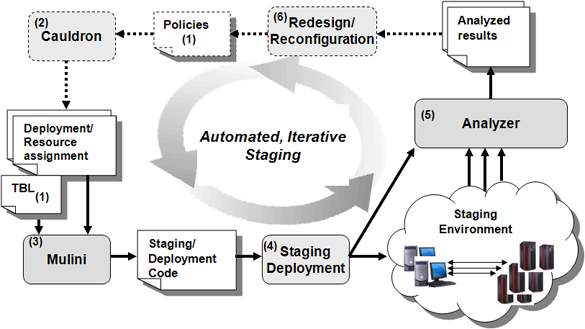Project Elba Update - ICDCS 2017 Announcement
Per our announcement at the 37th International Conference on Distributed Computing Systems (ICDCS'17), we are making our tools generally available under an Alpha release.
Please email elba@cc.gatech.edu to get these tools.
Directions can be found here
A Tutorial is under development and will be posted here.
Preliminaries for using our Alpha release effectively:
- You must request access to emulab.net if you do not have access to this NSF-funded infrastructure.
- Two Georgia Tech accounts are required: GTaccount and GT CoC account; we will provide these once you request our tools.
- Experiment generation and post-experiment processing should be executed in the environments prescribed by the directions.
Introduction to Project Elba
Background. One of the main research challenges in the Adaptive Enterprise vision is the automation of large application system management, encompassing design, deployment, to production use, and capturing application monitoring, evaluation, and evolution. Current approaches to enterprise system evaluation and tuning happen on production systems where the real workload to the deployed system is analyzed on-line and corresponding measurements are taken. In addition, many of these systems go through a detailed staging process that is mostly manual, complex and time-consuming. During the staging process the system to be produced is subjected to workloads to determine whether it will meet the production workloads. Finally, data gleaned from the staging process can be re-used to guide future designs and for management of system during operations.
Project Motivation. We want to verify and test an application system deployment plan in a staging environment before committing it to a production environment. Manual verification of a deployment is cumbersome, time consuming, and error prone. This problem will grow in importance in the deployment of increasingly larger and more sophisticated applications. Therefore, it will be increasingly important to have an automatic method for executing a benchmark on the deployment plan to validate the deployment during staging, instead of debugging a deployment during production use.
Contributions and Approaches
Automated Deployment and Staging Infrastructure
Approach. In our project we intend to automate the staging process thus reducing the time and manual labor involved in the process, increase confidence, and extract predictive performance data. Further, the automation will support a more thorough application test and validation in a larger state space, since we plan to automate the monitoring and analysis steps to speed up the refinement of application deployment. Our tools will translate a high-level specification of performance and availability (e.g., SLA requirements) into executable deployment, test, evaluation, and analysis code for the staging phase. This work builds on our experience and technology previously developed such as evaluation of SmartFrog and translation of Quartermaster design specifications into SmartFrog deployment programs.
System Architecture. The overall architecture of our project is shown in the figure below, where we achieve full automation in system deployment, evaluation, and evolution, by creating code generation tools to link the different steps of deployment, evaluation, reconfiguration, and redesign in the application deployment lifecycle.

Performance Cartography
Approach. In our evaluation, we have created a powerful infrastructure to generate the full set of experimental specifications to measure the performance of standard benchmarks over a wide range of hardware and software configurations. We have decided to use this infrastructure to study experimentally the performance variations of these benchmarks over a range of different configurations. Without our code generation infrastructure, past performance studies have been limited in scope due to practical problems of managing the number of experiments. We have used the Mulini code generator to create a large number of performance measurement experiments, run the experiments and collect/analyze data automatically, and used the analysis to generate Performance Maps.
System Architecture. The overall architecture of our project is shown in the figure above, where we achieve full automation in system deployment, evaluation, and evolution, by creating code generation tools to link the different steps of deployment, evaluation, reconfiguration, and redesign in the application deployment lifecycle.
Research Contributions. Currently, there is no reliable way to predict the performance of complex applications (e.g., N-Tier distributed application such as Rubis and TPC-App) in a complex environment(e.g., data centers). The limitations of analytical methods are due to the strong assumptions needed for solving the analytical models (e.g., based on queuing theory) that are valid only for relatively simple environments. The limitations of experimental measurements are due to the complexity of managing the many configuration combinations in practice. Our work leverages the Elba infrastructure (particularly, the Mulini generator) to generate and manage the experiments, and then use automated analysis techniques and tools to digest the information and create a Performance Map. The Performance Map is a reliable indicator of complex system performance, since it reflects actually measured experiments on the Performance Terrain (modulo tuning and other complications).
If you have comments or questions, please contact us at Elba Project. Thanks!